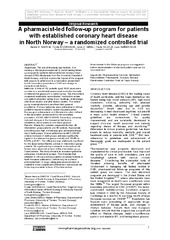A pharmacist-led follow-up program for patients with established coronary heart disease in North Norway – A randomized controlled trial [Programa farmacéutico de seguimiento para pacientes con enfermedad coronaria establecida en El Norte de Noruega – Ensayo controlado aleatorizado]
Permanent lenke
https://hdl.handle.net/10037/8687Dato
2015-06Type
Journal articleTidsskriftartikkel
Peer reviewed
Sammendrag
METHODS: A total of 102 patients aged 18-82 years were enrolled in a non-blinded randomized controlled trial with an intervention group and a control group. The intervention comprised medication reconciliation, medication review and patient education during three meetings; at discharge, after three months and after twelve months. The control group received standard care from their general practitioner. Primary outcomes were adherence to clinical guideline recommendations concerning prescription, therapy goal achievement and lifestyle education defined in the medication assessment tool for secondary prevention of CHD (MAT-CHDSP). Secondary outcomes included changes in the biomedical risk factors cholesterol, blood pressure and blood glucose.
RESULTS: Ninety-four patients completed the trial, 48 intervention group patients and 46 controls. Appropriate prescribing was high, but therapy goal achievement was low in both groups. Overall adherence to MAT-CHDSP criteria increased in both groups and was significantly higher in the intervention group at study end, 78.4% vs. 62.0%, p<0.001. The difference was statistically significant for the documented lifestyle advices in intervention group patients. No significant improvements in biomedical risk factors were observed in favor of the intervention group.
CONCLUSIONS: The study showed an increased guideline adherence in both study groups. This indicates that attention to clinical practice guideline recommendations in itself increases adherence - which may be a clinical pharmacist task. A larger adequately powered study is needed to show a significant difference in biomedical risk factor improvements in favor of the intervention. Amendments to the follow-up program are suggested before implementation in standard patient care can be recommended.


 English
English norsk
norsk